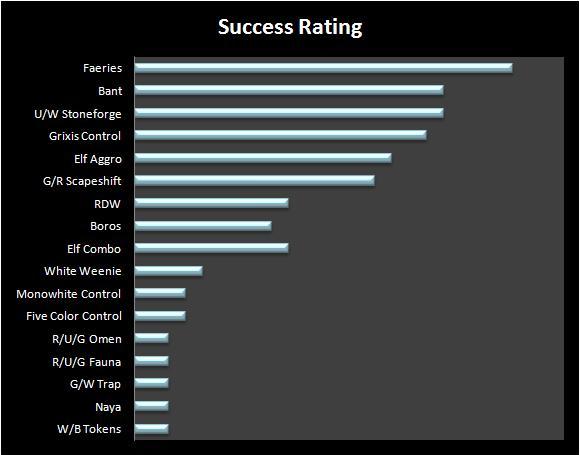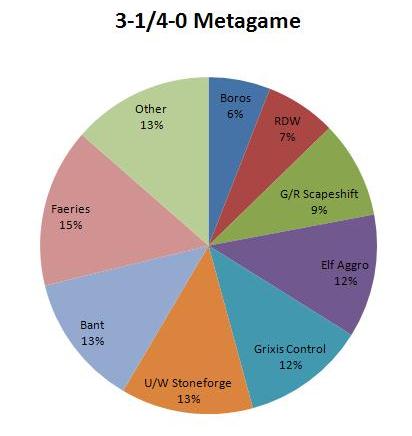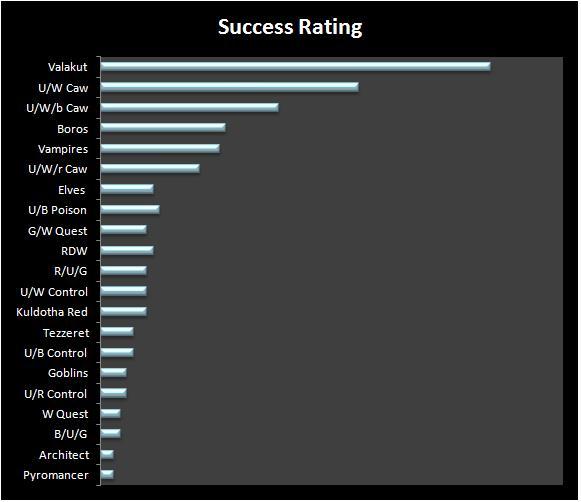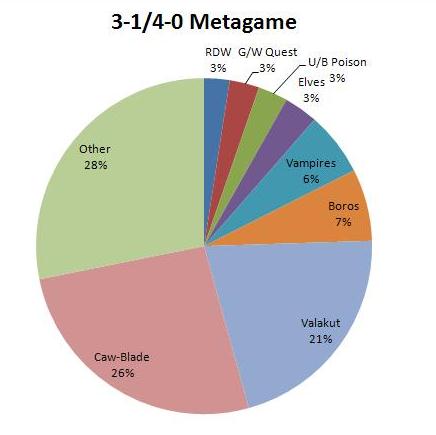Following up on last week, I again used the “Success Rating” method to give a snapshot of the Magic Online metagame. I awarded two points for every 4-0 finish and one point for
every 3-1 finish a deck earned. Relative Success Ratings for Extended, and later Standard, are shown in the bar charts. The pie charts show the overall
breakdown of archetypes among the 3-1 and 4-0 decks. This week, I looked at eighteen Extended Daily Events and ten Standard Daily Events (which are
much larger) from the period of March 14 through March 18.


Someone brought up a great point in the forums attached to last week’s article: Since I look at a
series of the same type of event from a small timeframe, a single, dedicated player can dramatically change the stats on their deck of choice. This
week, I counted at most one 4-0 finish from each player. Going undefeated in an MTGO Daily Event isn’t an everyday accomplishment, so, as you might
expect, I only had to scratch out a handful of results because of this policy.
It only changed my metagame analysis by a small amount, but I was happy to put in the extra effort because of the side benefit of being able to draw
attention to the players who are getting repeated, outstanding results. Here’s one of this week’s Extended all-stars:
Creatures (23)
- 1 White Knight
- 1 Burrenton Forge-Tender
- 4 Figure of Destiny
- 4 Knight of the White Orchid
- 2 Ranger of Eos
- 4 Steppe Lynx
- 3 Kor Firewalker
- 4 Student of Warfare
Lands (23)
- 15 Plains
- 4 Arid Mesa
- 4 Marsh Flats
Spells (14)

Two 4-0s and a 3-1 with Extended’s most underrated deck, White Weenie. There aren’t many surprises in Jonnie’s decklist either; he plays the same shell
as Paul Rietzl Pro Tour Amsterdam winning deck from last season. In a world full of Forge[/author]-Tender”]Burrenton [author name="Forge"]Forge[/author]-Tenders, Mirran Crusaders, Swords of Body and
Mind, and Swords of Feast and Famine, the man with the mono-white deck might just be king. White Weenie is appealing in a format with so many slower
creature decks, and the free wins it earns from Red Deck Wins might just put it over the top.
Bant and U/W Stoneforge have really changed the Extended metagame. Sword of Feast and Famine makes life harder on Scapeshift, Faeries, and pure
control, which were the major players a month ago. Today, an overwhelming portion of the field is made up of creature decks. In addition to the
straightforward Bant, Elves, Jund, Naya, Boros, and White Weenie, Faeries and U/W Stoneforge are the format’s most popular permission decks and still
lean heavily on creatures. Even one of the biggest combo decks sports thirty-four creatures.
My main focus this week is what PTQ players should be doing to adapt to this new environment. In my opinion, the best and simplest choice is to choose
a deck that really beats up on creature strategies. One recommendation is G/R Scapeshift. Yes, Sword of Feast and Famine combined with heavy permission
is difficult to beat; however, the matchup will quickly become a nightmare for Bant players who skimp on permission to improve their chances in the
mirror and against other creature decks. Personally, I’ve been battling with Elf Combo.
Creatures (34)
- 4 Llanowar Elves
- 4 Heritage Druid
- 3 Devoted Druid
- 4 Nettle Sentinel
- 3 Regal Force
- 4 Elvish Visionary
- 4 Elvish Archdruid
- 4 Arbor Elf
- 1 Joraga Warcaller
- 2 Joraga Treespeaker
- 1 Ezuri, Renegade Leader
Lands (18)
Spells (8)
Sideboard

The combo aspect makes Elf mirrors a breeze. Decks that rely on one-for-one removal get overwhelmed by Elvish Visionary, Ranger of Eos, and Primal
Command. Bant can only compete because Mirran Crusader fights dirty, but he has to spend his time in the penalty box once Path to Exile comes off the
sideboard. Undisrupted, this deck casts a turn 3 Primal Command with great consistency, making it hard for Scapeshift to reach six mana and hard for a
regular deck to even get to four.
My only complaint is that Elf Combo is very difficult to pilot. Goldfishing gives me a headache. Playing optimally around the threat of various
sweepers, spot removal, and permission is almost comically difficult. I feel like I could play this deck for another six months and not master it. I
strongly recommend Elf Combo but only for someone who has time to get in a solid amount of testing before a big tournament.
I can’t talk about G/W Elf Combo without discussing the more popular Elf build. These days, the line is a bit blurry between Elf Aggro and Elf Combo.
In my stats, I used the presence of cards like Bramblewood Paragon and Joraga Warcaller (in four copies) to designate Elf Aggro. However, these decks
can generate overwhelming card advantage with Lead the Stampede and can use Heritage Druid similarly to Elf Combo to put out a hundred power worth of
creatures on turn 2 or 3.
Elf Aggro is undeniably a very good deck. I’d normally recommend White Weenie as a deck that’s excellent for creature mirrors; however, Elves simply
rolls over any deck without sufficient removal. That said, Elf Combo is the better strategy in my opinion. The Bramblewood Paragon deck is an example
of the type of straightforward creature deck that I advise PTQ players to gun for.
Here are some quick ideas for how Extended’s major players can maximize their chances in the creature-dominated metagame:
Faeries
should maindeck plenty of instant-speed creature removal. Even in the mirror or against U/W Stoneforge, taking out a creature in response to an equip
can provide game-changing tempo. I recommend three Disfigures and three Go for the Throats. One Infest in the sideboard will also go a long way against
Elves and decks with Mirran Crusader. Sword of Feast and Famine is great in Faeries, but an alternative would be to return to a Scion of Oona build
(maybe only five removal spells in this case). Scion is one of the absolute scariest cards that I could see as a Bant or an Elf Aggro player. The card
also performs at a whole other level when it’s 100% unexpected as it is right now. At any rate, Faeries players can expect some reprieve in the coming
weeks because aggro players will be forced to trim their Great Sable Stags if they want an edge in creature mirrors.
U/W Stoneforge, regardless of what the maindeck looks like, should have enough all-purpose control cards in the sideboard to be able to swap out the Stoneforge
package. Classic U/W is the better deck in a lot of the creature matchups, and taking maximum advantage of Day of Judgment should be a great way to win
a PTQ. This same concept applies to Standard, and I hope to elaborate on it in an article sometime soon.
G/R Scapeshift
should play Lightning Bolt. It’s the best card against Bant and will usually shift a race in your favor against Elves.
Bant
should have a maindeck geared for creature matchups and a sideboard full of potent hate cards to shore up the other matchups. Maximize efficient,
targeted removal and threats that demand an immediate answer. Linvala, Keeper of Silence can dominate a game in the mirror and is simply unfair against
Elf Combo. I don’t recommend sideboarding Day of Judgment, but I do recommend playing around it in the mirror, as it’s becoming popular. If your
opponent doesn’t kill or match your Knight of the Reliquary postboard in the mirror, something fishy is going on. After all, they’re sure to have eight
or more removal spells, and why would they keep a hand without fast creatures or removal?
Here’s the Bant list I would play right now:
Creatures (23)
- 4 Birds of Paradise
- 4 Noble Hierarch
- 4 Knight of the Reliquary
- 4 Qasali Pridemage
- 3 Stoneforge Mystic
- 4 Mirran Crusader
Planeswalkers (3)
Lands (24)
Spells (10)



This week’s Standard features all the usual suspects. U/W/b Caw-Blade performed very well online in addition to taking first place in the
StarCityGames.com Open in Dallas in the hands of Gerry Thompson. Granted, he could probably make the finals next weekend with a preconstructed deck.
Speaking of dominant players, here’s one who scored two 4-0 finishes with a deck nobody else seems to be playing:
Creatures (13)
Planeswalkers (4)
Lands (27)
Spells (16)
Sideboard

If you only remember one thing from this article, make it the nonsensical string of twenty letters in this guy’s name—he knows his Standard. Actually,
maybe should you should just remember the gist of his decklist: classic but threat-heavy R/U/G Ramp. Each of his big creatures demands an immediate Day
of Judgment from Caw-Blade. While they’re tapped out for it, he has free rein to play a follow-up creature or Jace, the Mind Sculptor. There’s nothing
like watching your opponent spend their turn 3 on a 1/1 flying creature when you can play a Titan on yours.
It seems to me like there’s potential in Standard’s fringe strategies like Tezzeret, Infect, and Fauna Shaman; however, so far these Daily Events
haven’t shown a consensus on how they should be built. Nevertheless, I’m seeing creative use of powerful cards like Kuldotha Phoenix and Spine of Ish
Sah that gives me hope that Caw-Blade won’t continue winning every Standard tournament this season.
